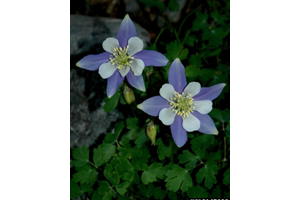Aquilegia is the Latin word for eagle, with the flower's five spurs resembling eagle talons. This species is Colorado's state flower. It is used medicinally as a salve, resolvent, diaphoretic, and parasiticide.
Photo Credit: © William M. Ciesla, Forest Health Management International, Bugwood.org.
Aquilegia coerulea
Common Name: Colorado blue columbine
Other Scientific Names: Aquilegia caerulea
Plant Functional Group: Forb
Class > Order > Family: Magnoliopsida > Ranunculales > Ranunculaceae
What does the species look like?
Colorado blue columbine is a perennial, herbaceous plant that lives for 4 to 5 years. The plant is bushy and forms clumps 6 to 32 feet tall. Its blue and white (and sometimes pinkish and white) flowers are showy with each flower containing both male and female parts. They are insect- and hummingbird-pollinated.
Colorado blue columbine grows in partly shady, moist, well-drained sites, with rich soils. It is found in montane and subalpine zones in open meadows, open woodlands, rocky talus slopes, or near streams.
Where is the species found?
States & Provinces
AZ, CO, ID, MT, NM, NV, SD, UT, WY
Special Considerations for Observing
If drought seems to be the cause of leaf senescence for a plant, please make a comment about it for that observation.
Which phenophases should I observe?
Do you see...?
Leaves
Initial growth More...
Leaves More...
Flowers
Flowers or flower buds More...
How many flowers and flower buds are present? For species in which individual flowers are clustered in flower heads, spikes or catkins (inflorescences), simply estimate the number of flower heads, spikes or catkins and not the number of individual flowers.
Less than 3 3 to 10 11 to 100 101 to 1,000 More than 1,000
Open flowers More...
What percentage of all fresh flowers (buds plus unopened plus open) on the plant are open? For species in which individual flowers are clustered in flower heads, spikes or catkins (inflorescences), estimate the percentage of all individual flowers that are open.
Less than 5% 5-24% 25-49% 50-74% 75-94% 95% or more
Fruits
Fruits Aquilegia coerulea , the fruit is five-pronged and capsule-like and changes from green to tan or brown and splits open to expose the seeds. Do not include empty fruits that have already dropped all of their seeds.More...
How many fruits are present?
Less than 3 3 to 10 11 to 100 101 to 1,000 More than 1,000
Ripe fruits Aquilegia coerulea , a fruit is considered ripe when it has turned tan or brown and has split open to expose the seeds. Do not include empty fruits that have already dropped all of their seeds.More...
What percentage of all fruits (unripe plus ripe) on the plant are ripe?
Less than 5% 5-24% 25-49% 50-74% 75-94% 95% or more
Recent fruit or seed drop More...
How many mature fruits have dropped seeds or have completely dropped or been removed from the plant since your last visit?
Less than 3 3 to 10 11 to 100 101 to 1,000 More than 1,000
What do these phenophases look like?
There is currently no photoguide available for this species. If you'd like help us create one, use the guidance document and species template provided here . Then send it via email to education@usanpn.org when it is complete.
